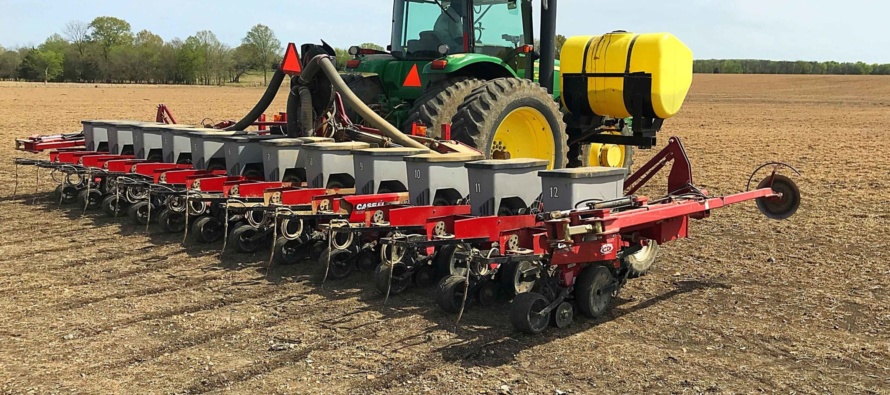How Late Can We Plant Corn?

Related Articles
- 2010 Soybean And Corn Variety Trial Data 3
- Flag The Technology 0
- Spring Nitrogen Fertility Suggestions for Wheat 0
Latest Tweets
Recent rains have temporarily halted planting progress across much of the state. It is well known that corn is normally more productive when planted early, primarily because its’ sensitive reproductive development occurs when environmental conditions are more favorable. Accordingly, there is also some uneasiness regarding corn productivity when corn planting is delayed into April or even later. Also, corn planting intentions are higher this year than in the recent past, so there may be more deliberation regarding how to proceed regarding planting intentions during the next few weeks.
Although planting date garners a lot of attention, please remember this is only one of the many factors that ultimately determine corn productivity. In fact, a grower who contemplated this process last spring reminded me after harvest that his most productive corn turned out to be that which he almost didn’t plant. This was likely because his early-planted corn struggled to develop a uniform, vigorous stand due to cool, wet conditions last spring. Therefore, poor stand quality was more detrimental to productivity than the benefit associated with early planting. Considering the cool, wet conditions we’ve experienced thus far this spring, this may cause some issues once again. Therefore, keep in mind that planting date is only one piece of the management puzzle.
I am sure many are wondering whether to continue planting corn, or whether planting delay may dictate a change of crop intentions. Fortunately, we have a strong research database produced at Mississippi State University to help answer this question. The primary objective of this research was to evaluate the yield response of modern corn hybrids, possessing Bt technology for corn borer protection, to well later than normal planting dates. Thus, we can utilize this information to make better cropping decisions, particularly when rainfall delays planting, or we are faced with replanting decisions.
Irrigated corn planting date field studies were conducted in 2009, 2010 and 2011 at the MSU Delta Research and Extension Center at Stoneville and the RR Foil Research Center at Mississippi State University using furrow irrigation. Corn produced optimal grain yields until about May 1, when productivity began to fall. Corn yield loss was relatively moderate through May and declined more substantially in June. The magnitude of irrigated corn yield reduction associated with planting beyond the optimum time frame was 1.3 bu. per day or 0.76% per day for plantings during May and increased to 2.1 bu. per day or 1.59% per day for June plantings. The numbers on the X-axis in the figures below represent the Julian date of the year (75=March 16, 165=June 14). The trendline shows the yield response of five hybrids (each represented by a different color) planted at 2 to 2 ½ week intervals over the duration of the study.
Dryland studies were conducted at the RR Foil Research Center at Mississippi State University in 2010, 2011 and 2012. Corn planted at later dates grown in dryland culture suffered more consistent yield loss than irrigated corn. However, pollination failure or catastrophic yield loss never occurred, despite corn being exposed to two of the most severe drought seasons in Mississippi history during 2010 and 2011. The magnitude of dryland corn yield reduction was 1.3 bu. per day or 0.83% per day for plantings after Mid-April. Although substantial, this yield loss was relatively moderate and not substantially different from Corn Belt studies. The numbers on the X-axis in the figure below represent the Julian date of the year (95=April 5, 155=June 4). The trendline shows the response of five hybrids (each represented by a different color) planted at 2 to 2 ½ week intervals over the duration of the study.
This research produced several key findings:
- Corn yield response to planting date differs substantially depending upon whether the corn is grown with supplemental irrigation, or grown in a dryland environment – where moisture supply is dependent upon rainfall. Corn grown in dryland conditions is more vulnerable to yield loss associated with delayed planting, than corn grown with irrigation.
- Modern corn hybrids (including Bt corn borer protection) grown with supplemental irrigation sustain high productivity much longer through April than expected. In fact, corn productivity didn’t begin to significantly decline until nearly May 1 at a Highway 82 latitude.
- Yield loss associated with late planting of dryland corn in Mississippi is gradual and steady, and is similar to responses documented throughout the Corn Belt.
- In summary, there is little justification to hastily cut-off or terminate corn planting relative to calendar date due to dramatic yield reduction.






Let me tell You a sad story ! There are no comments yet, but You can be first one to comment this article.
Write a comment